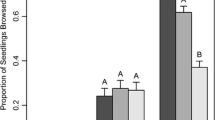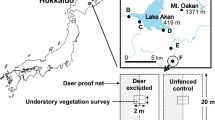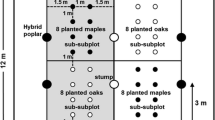Abstract
To measure the effects of white-tailed deer (Odocoileus virginianus) herbivory on seeds, seedlings, and young saplings of Quercus buckleyi on the eastern Edwards Plateau of central Texas, USA, experimental fenced deer exclosures were constructed. Acorns or small Q. buckleyi transplants were placed in each exclosure and in each unfenced control plot. Deer did not significantly affect acorn survival and germination, but did significantly reduce transplant survival and growth rates. The results support the hypothesis that deer are responsible for the failure of recruitment into adult size classes in Q. buckleyi populations in this region. Without adult recruitment of Q. buckleyi, the species composition and possibly even the physiognomy of woodlands on the eastern Edwards Plateau will change markedly. The results of this experiment also indicate that, although juniper (Juniperus ashei) and Q. buckleyi presumably compete for water, light, and nutrients, in the presence of deer junipers can have a positive effect on seedlings and saplings of Q. buckleyi, a case of facilitation. In the presence of deer the transplants increased in height significantly more slowly away from juniper saplings than they did beneath juniper saplings, probably due to the physical protection from browsing that junipers provided to the transplants.
Similar content being viewed by others
References
Allison P.D. 1995. Survival analysis using the SAS system: a practical guide. SAS Institute Inc., Cary, NC, USA.
Alverson W.S. and Waller D.M. 1997. Deer populations and the widespread failure of hemlock regeneration in northern forests. pp. 280–297. In: McShea W.J., Underwood H.B. and Rappole J.H. (Eds.), The science of over-abundance: deer ecology and population management. Smithsonian Institution Press, Washington, D.C.
Anderson R.C. and Loucks O.L. 1979. White-tailed deer (Odocoileus virginianus) influence on structure and composition of Tsuga canadensis forests. Journal of Applied Ecology 16: 855–861.
Armstrong W.E., Harmel D.E., Anderegg M.J. and Traweek M.S. 1991. Vegetation of Kerr wildlife management area and its preference by white-tailed deer. Federal aid report series No. 30, Texas Parks and Wildlife Department, Austin, TX, USA.
Barnes R.F.W. 1983. Effects of elephant browsing on woodlands in a Tanzanian National Park: Measurements, models and management. Journal of Applied Ecology 20: 521–540.
Belsky A.J. 1989. Landscape patterns in a semi-arid ecosystem in East Africa. Journal of Arid Environments 17: 265–270.
Ben-Shahar R. 1996. Woodland dynamics under the influence of elephants and fire in northern Botswana. Vegetatio 123: 153–163.
Ben-Shahar R. 1998. Changes in structure of savanna woodlands in northern Botswana following the impacts of elephants and fire. Plant Ecology 136: 189–194.
Bertness M.D. and Callaway R.M. 1994. Positive interactions in communities. Trends in Ecology and Evolution 9: 191–193.
Bond W.J., Smythe K. and Balfour D.A. 2001. Acacia species turnover in space and time in an African savanna. Journal of Biogeography 28: 117–128.
Borchert M.I., Davis F.W., Michaelsen J. and Oyler L.D. 1989. Interactions of factors affecting seedling recruitment of blue oak (Quercus douglasii) in California. Ecology 70: 389–404.
Borgmann K.L., Waller D.M. and Rooney T.P. 1999. Does Balsam Fir (Abies balsamea) facilitate the recruitment of eastern hemlock (Tsuga Canadensis). American Midland Naturalist 141: 391–397.
Brown J.R. and Archer S. 1989. Woody plant invasion of grasslands: establishment of honey mesquite (Prosopis glandulosa var. glandulosa) on sites differing in herbaceous biomass and grazing history. Oecologia 80: 19–26.
Callaway R.M. 1995. Positive interactions among plants. The Botanical Review 61: 306–349.
Callaway R.M. and Davis F.W. 1993. Vegetation dynamics, fire and the physical environment in coastal central California. Ecology 74: 1567–1578.
Callaway R.M. and King L. 1996. Temperature-driven variation in substrate oxygenation and the balance of competition and facilitation. Ecology 77: 1189–1195.
Callaway R.M., Kikvidze Z. and Kikodze D. 2000. Facilitation by unpalatable weeds may conserve plant diversity in overgrazed meadows in the Caucasus Mountains. Oikos 89: 275–282.
Caughley G. 1976. The elephant problem – an alternative hypothesis. East African Wildlife Journal 14: 265–283.
Correll D.S. and Johnson M.C. 1979. Manual of the vascular plants of Texas. The University of Texas at Dallas, Richardson, TX, USA.
Davis W.B. 1978. The mammals of Texas. Texas Parks and Wildlife Department, Austin, TX, USA.
Dublin H.T., Sinclair A.R.E. and McGlade J. 1990. Elephants and fire as causes of multiple stable states in the Serengeti-Mara woodlands. Journal of Animal Ecology 59: 1147–1164.
Fox G.A. 1993. Failure-time analysis: emergence, flowering, survivorship and other waiting times. pp. 253–290. In: Scheiner S.M. and Gurevitch J. (Eds.), Design and analysis of ecological experiments. Chapman and Hall, New York.
Griffin J.R. 1971. Oak regeneration in the Upper Carmel Valley, California. Ecology 52: 862–868.
Hahn H.C. 1945. The white-tailed deer in the Edwards Plateau region of Texas. Texas Game, Fish and Oyster Commision, Austin, TX, USA.
Inouye R.S., Allison T.D. and Johnson N.C. 1994. Old field succession on a Minnesota sand plain: effects of deer and other factors on invasion by trees. Bulletin of the Torrey Botanical Club 121: 266–276.
Kelly C.A. and Dyer R.J. 2002. Demographic consequences of inflorescence-feeding insects for Liatris cylindracea, an iteroparous perennial. Oecologia (Berlin) 132: 350–360.
Lange R.T. and Graham C.R. 1983. Rabbits and the failure of regeneration in Australian arid zone Acacia. Australian Journal of Ecology 8: 377–381.
Lange R.T. and Willcocks M.C. 1980. Experiments on the capacity of present sheep flocks to extinguish some tree populations of the south Australian arid zone. Journal of Arid Environments 3: 223–229.
Larkin T.J. and Bomar G.W. 1983. Climatic atlas of Texas. Texas Department of Water Resources, Austin, TX, USA.
Louda S. 1982. Limitation of the recruitment of the shrub Haplpappus squarrosus (Asteraceae) by flower-and seed-feeding insects. Journal of Ecology 70: 43–53.
Louda S.M. 1996. Insect herbivory as a major factor in the shade distribution of a native crucifer (Cardamine cordifolia A. Gray). Journal of Ecology 84: 229–238.
Louda S. and Potvin M.A. 1995. Effect of inflorescence-feeding insects on the demography and lifetime fitness of a native plant. Ecology 76: 229–245.
McAuliffe J.R. 1986. Herbivore-limited establishment of a Sonoran desert tree, Cercidium microphyllum. Ecology 67: 276–280.
McInnes P.F., Naiman R.J., Pastor J. and Cohen Y. 1992. Effects of moose browsing on vegetation and litter in the boreal forest, Isle Royale, Michigan, USA. Ecology 73: 2059–2075.
McMahan C.A. 1964. Comparative food habits of deer and three classes of livestock. Journal of Wildlife Management 28: 798–808.
McPherson G.R. and Wright H.A. 1990. Effects of cattle grazing and Juniperus pinchotii canopy cover on herb cover and production in western Texas. American Midland Naturalist 123: 144–151.
Mensing S.A. 1992. The impact of European settlement on Blue oak (Quercus douglasii) regeneration and recruitment in the Tehachapi Mountains, California. Madrono 39: 36–47.
Parker M.A. 1985. Size-dependent herbivore attack and the demography of an arid grassland shrub. Ecology 66: 850–860.
Pellew R.A.P. 1983. The impacts of elephant, giraffe and fire upon Acacia tortillas woodlands of the Serengeti. African Journal of Ecology 81: 41–74.
Prins H.H.T. and van der Jeugd H.P. 1993. Herbivore population crashes and woodland structure in east Africa. Journal of Ecology 81: 305–314.
Pugnaire F.I., Haase P. and Puigdefabregas J. 1996. Facilitation between higher plant species in a semiarid environment. Ecology 77: 1420–1426.
Rooney T.P., McCormick R.J., Solheim S.L. and Waller D.M. 2000.Regional variation in recruitment of hemlock seedlings and saplings in the upper Great Lakes, USA. Ecological Applications 10: 1119–1133.
Rousset O. and Lepart J. 2000. Positive and negative interactions at different life stages of a colonizing species (Quercus humilis). Journal of Ecology 88: 401–412.
Russell F.L. 1999. Effects of white-tailed deer (Odocoileus virginianus) on the dynamics and structure of Spanish oak (Quercus buckleyi) populations on the eastern Edwards Plateau, Texas. Ph.D. dissertation, University of Texas at Austin, Austin, TX, USA.
Russell F.L. and Fowler N.L. 1999. Rarity of oak saplings in savannas and woodlands of the eastern Edwards Plateau, Texas. Southwestern Naturalist 44: 31–41.
Russell F.L. and Fowler N.L. 2002. Failure of adult recruitment in Quercus buckleyi populations on the eastern Edwards Plateau, Texas. American Midland Naturalist 148: 201–217.
Tilghman N.G. 1989. Impacts of white-tailed deer on forest regeneration in northwestern Pennsylvania. Journal of Wildlife Management 53: 524–532.
Van Auken O.W. 1988. Woody vegetation of the southeastern escarpment and plateau. pp. 43–56. In: Amos B.B. and Gehlbach F.R. (Eds.), Edwards Plateau vegetation: plant ecological studies in central Texas. Baylor University Press, Waco, TX, USA.
Van Auken O.W., Ford A.L. and Allen J.L. 1981. An ecological comparison of upland deciduous and evergreen forests of central Texas. American Journal of Botany 68: 1249–1256.
Weltzin J.F., Archer S. and Heitschmidt R.K. 1997. Small-mammal regulation of vegetation structure in a temperate savanna. Ecology 78: 751–763.
Werchan L.E., Lowther A.C. and Ramsey R.N. 1974. Soil survey of Travis County, Texas. United States Department of Agriculture, Soil Conservation Service, Washington, D.C.
White K. 1966. Structure and composition of foothill woodland in central coastal California. Ecology 47: 229–237.
Yeaton R.I. 1988. Porcupines, fire and the dynamics of the tree layer of the Burkea africana savanna. Journal of Ecology 76: 1017–1029.
Zippin D.B. 1997. Herbivory and the population biology of a rare annual plant, the bracted twistflower (Streptanthus bracteatus). Ph.D. dissertation, University of Texas at Austin, Austin, TX, USA.
Author information
Authors and Affiliations
Corresponding author
Rights and permissions
About this article
Cite this article
Russell, F.L., Fowler, N.L. Effects of white-tailed deer on the population dynamics of acorns, seedlings and small saplings of Quercus buckleyi . Plant Ecology 173, 59–72 (2004). https://doi.org/10.1023/B:VEGE.0000026329.47461.99
Issue Date:
DOI: https://doi.org/10.1023/B:VEGE.0000026329.47461.99




